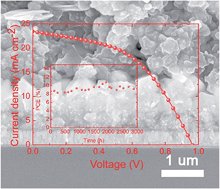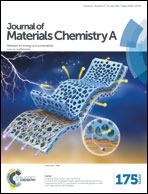Enhanced photovoltaic performance and stability of carbon counter electrode based perovskite solar cells encapsulated by PDMS†
Abstract
We report the encapsulation of low temperature carbon counter electrode based hole-conductor-free mesoscopic methylammonium lead iodide perovskite/TiO2 heterojunction solar cells with polydimethylsiloxane. The solar cells demonstrate improved photovoltaic performance, where we obtain an optimal short-circuit photocurrent JSC = 23.5 mA cm−2, open-circuit photovoltage VOC = 0.97 V, and fill factor FF = 0.474, corresponding to a light to electric power conversion efficiency of 10.8% under a standard AM 1.5 solar light of 100 mW cm−2 intensity. The results exhibit a remarkable 54% enhancement over those without encapsulation. The cross-sectional SEM images indicate that the PDMS layer can condense the carbon electrode by filling the gaps in the mesoscopic carbon film during the solidification of PDMS, resulting in an improved MAPbI3/carbon interface condition. The photoluminescence and electrical impedance spectroscopy measurements prove that the improved efficiency is ascribed to a more efficient charge transfer process and slower charge recombination between interfaces. In addition, the robust polydimethylsiloxane isolates water in air, avoiding the degradation of the CH3NH3PbI3 perovskite and leading to an impressive stability during a testing period of 3000 h. Our work paves the way for realizing low cost, highly efficient and stable hybrid photovoltaic cells.

- This article is part of the themed collection: JMC A Editor’s choice collection: Recent advances in photovoltaics

 Please wait while we load your content...
Please wait while we load your content...